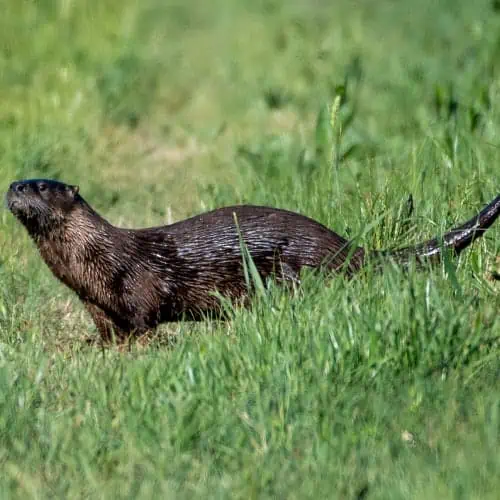
Alabama is situated in the southeast of the United States, and is home to a variety of landscapes, from mountainous regions to coastal plains to prairies. The climate is temperate, with an average precipitation of 56 inches per year, and the state is frequently hit by hurricanes and tornadoes.
Over 6,350 species call Alabama home, and it is known as one of the most biologically diverse states, ranking first in diversity for many freshwater species: mussels, fishes, snails, and turtles.
The warm climate and plentiful rainfall mean that Alabama has cultivated a great variety of plants and trees, which in turn support an abundance of wildlife. This includes various reptiles, such as alligators and rattlesnakes, many birds, including woodpeckers, blue jays, and hawks, and mammals, such as bears, armadillos, and even Alabama’s only otter species, which you can read more about below!
Alabama Otters
1) North American River Otter (Lontra canadensis)

- Family: Emydidae
- Order: Carnivora
- Length (Fully Grown): 0.9-1.2 meters
- Conservation status: Least concern
Diet
North American river otters have a varied diet, including fish, crayfish, crabs, frogs, birds’ eggs, reptiles, aquatic plants, and even rabbits. Research has found that fish comprise the majority of their diet, especially those of the Salmonidae (salmonid) and Cottidae (sculpin) families. Individuals will also vary their diet depending on the seasonal availability of different food sources: crayfish, for example, are much less available in winter, whereas otters freely feed upon them throughout the summer. With a high metabolic rate, the otters need to feed regularly.
Distribution

The North American river otter is the only species of otter found in Alabama. It is so widespread throughout North America that its native range is difficult to determine. Being a highly adaptable species, it can be found in much of Canada and the United States, with the exception of a few areas in the southwest.
There are seven subspecies of Lontra canadensis, which show subtle variations depending on their distribution. The subspecies present in Alabama is Lontra canadensis canadensis, the most common of the subspecies.
Physiology
This species is perfectly adapted for life in the water; with a long, streamlined body and short legs, they are flexible and able to maneuver themselves with ease. Their strong tail functions as a rudder and helps, in combination with their muscular shoulders, to propel the otter through the water.
Two types of hair make up the river otter’s coat, which is dark brown, fading to pale brown on the belly, chest, and chin. These are guard hairs, which function to trap air bubbles, providing the otter with buoyancy and keeping the skin dry, and underhairs. Under an electron microscope, underhairs have been found to interlock to prevent water from getting through.
Behavior
River otters are a charismatic species, spending a large proportion of their time playing. They tend to exist in familial groups, with one female and her offspring, and although largely nocturnal, without human disturbance they will often come out during the daytime as well. Play consists of wrestling, sliding down muddy banks, and tail chasing, all of which strengthen social bonds and enable individuals to practice hunting techniques.
Communication between river otters includes a variety of vocalizations, posturing, and scent marking. Scent marking has been proposed as a strategy to display reproductive status and retain territories, although it has also been noted that male river otters will not approach a female that has recently had cubs, an event that is communicated via scent.
Conservation Status
The North American river otter does not currently have any specific conservation concerns associated with it, and the population in Alabama is classed as ‘secure’. Declines have been previously noted, with the species even having been extirpated in many areas before 1900, and then gradually reintroduced. River otters are highly sensitive to aquatic pollution, disease, and endoparasites, all of which may present threats to the current population.
In some areas, river otters are considered a pest, as they may cause damage to aquaculture facilities by getting in and feeding on the fish. Other damage, such as that to gardens or attacks on dogs, is not impossible but is a very rare occurrence.
Preventative measures are recommended to reduce human-wildlife conflict in these scenarios. Mesh fencing may be used to keep otters away from fisheries, and electric fencing may also be used, although it requires regular maintenance to ensure continued effectiveness.
Culling of otters is legal in Alabama. This may be done by shooting, or by poisoning with carbon dioxide. It is illegal to relocate otters in Alabama.

